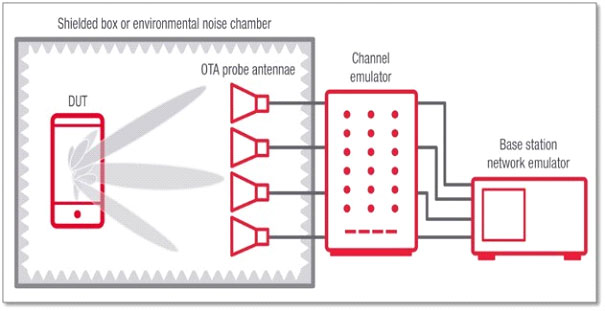The development of 5G standards and their commercial rollout appears to be on a fast track. Mobile operators and network equipment makers have been conducting field trials and the first smart phones are expected out early this year. According to “The State of 5G” market study, “nearly half of global businesses are already deploying 5G networks, or plan to deploy them within the next 12 months.”
Are we at the tipping point? What exactly is a tipping point, and why might we be there? The Merriam-Webster’s definition says that a tipping point is a point of no return, after which significant transformation occurs. 5G New Radio (NR) has come a long way with Release-15 standard frozen in June 2018. You may hear some industry experts say the standards are complete, but are they really?
Will 5G NR products live up to consumer expectations? If they do not live up to expectations, what is the impact on the industry and product development? Let’s explore where we are in the 5G NR rollout with respect to required tests, challenges, and risks.
5G Required Tests
5G products and components require testing through the ecosystem, including modems, antennas, sub-systems, and fully assembled end-user devices. All of these devices and base stations will follow with a similar testing workflow: research and development (R&D), design validation, conformance, and device-acceptance testing.
 With many rules and regulations to follow in order to bring a mobile wireless communications product to market, testing is performed throughout a product’s lifecycle to ensure the end product meets Third Generation Partnership Project (3GPP) specifications and delivers the quality of service mobile operators aim to deliver to their customers.
With many rules and regulations to follow in order to bring a mobile wireless communications product to market, testing is performed throughout a product’s lifecycle to ensure the end product meets Third Generation Partnership Project (3GPP) specifications and delivers the quality of service mobile operators aim to deliver to their customers.
Conformance tests are mandatory tests that must be completed to release a device. Conformance tests are a key requirement and involve connecting a device to a wireless test system and performing the required 3GPP tests:
- Radio frequency (RF) transmission and reception performance – minimum level of signal quality
- Demodulation – data throughput performance
- Radio resource management (RRM) – initial access, handover, and mobility
- Signaling – upper layer signaling procedures.
3GPP Standards identify a minimum level of performance for user equipment (UE) terminals and base stations (gNB). These requirements are defined in the RAN4 and RAN5 technical specifications (TS):
- RAN4 defines minimum requirements for base stations and UEs. It also specifies test cases and test methods for base station conformance tests.
- RAN5 defines the UE conformance test specifications and test methods.
5G NR products can operate in two frequency ranges – frequency range 1 (FR1: 450 MHz to 6 GHz) or frequency range 2 (FR2: 24.25 to 52.6 GHz), or both FR1 and FR2. Testing in FR1 below 6 GHz is firmly established with well understood test methods and associated uncertainties.
Given that FR1 below 6 GHz operates under the same characteristics, tests in FR1 will be similar to that of LTE with most conformance tests performed with a cable connected to the device, and antenna characteristics, and multiple input multiple output (MIMO) performance completed over the air (OTA).
FR2 at millimeter-wave (mmWave) frequencies adds a completely new twist on OTA sinceall measurements in FR2 will be tested OTA.
You can find the minimum requirements and the conformance test specifications and test methods for all frequency ranges in the following 3GPP documents:
| Minimum Requirements | Conformance Tests | |
| Base Station | TS 38.104 |
|
| User Equipment | TS 38.101 |
|
Conformance tests are performed by third-party test labs to determine if a product is compliant. These tests are expensive, driving most companies to conduct their own pre-conformance tests to ensure their product will successfully pass these tests at independent laboratories. Currently, these tests are still in development and will be defined over the next year for different use cases.
New Features Mean New Test Challenges
5G NR introduces many new features that increase test complexity. Higher frequency operation, wider channel bandwidths, flexible waveform structure, and the increasing number of test cases that need to be validated all impact test design. For the most part, testing designs under 6 GHz in FR1 is similar to that of LTE. The key challenges lie in testing designs operating between 3.5 GHz and 6 GHz that use wider bandwidths and massive MIMO, and designs operating in FR2 because they require OTA tests methods. OTA introduces many new challenges not yet experienced by UE and base station designers, and has big implications for the test environment.
User Equipment Test Challenges: 5G NR needs to accommodate many different usage scenarios from very high throughput to low packet size, to very low latencies with high reliability. To support such a wide variety of use cases, the 5G NR physical layer was defined with high flexibility, changing the way signals are created and operate. In addition, there are seven different system architecture options and dual connectivity with 4G LTE that will be implemented. Testing must be performed for the many different use cases. Furthermore, it involves signaling and RF tests, including testing for full end-to-end performance with real-world impairments like excessive path loss, multi-path fading, and delay spread. Testing these functions requires an OTA test solution that can emulate base station protocols and channel conditions to understand the true performance of UEs.

Figure 1. Simplified OTA solution with a network emulator and channel emulator.
The drastic increase in the number of test cases that need to be validated during development, for conformance, and device acceptance testing, directly increase test complexity and test times. Ensuring that you are testing to the latest specifications and getting regular 5G NR test software updates are critical to minimize the risk of parallel development, reduce costly rework, and ensure that designs meet evolving 5G NR requirements.
Base Station Test Challenges: The active nature of 5G beam steering and beamforming requires validation in an OTA setting. Key aspects such as antenna gain, side lobe, and null depth for the full range of 5G frequencies and bandwidths can have a major impact on system performance. In particular, 3D antenna beam measurements introduce many complexities into the test.
While increased path loss and signal impairments were not an issue at 6 GHz and below, such phenomena are problematic at mmWave frequencies. Therefore, test solutions for mmWave frequencies not only need to accommodate higher frequencies with wider channel bandwidths, but also address higher path loss at mmWave frequencies. To that end, a test solution must have adequate signal-to-noise ratio (SNR) to accurately detect and demodulate 5G signals.
When testing transmitters, SNR is critical in the test analyzer to make accurate error vector magnitude (EVM) and adjacent channel leakage ratio (ACLR) measurements, and even more so for those testing at mmWave frequencies. To improve SNR in a test solution used to test receivers, the use of signal generators with higher output power per EVM and ACLR becomes important. In addition, system-level calibration is also critical to correct for system level phase and magnitude shifts over the bandwidth of the measurement. See how a corrected waveform will correct for channel response at the device under test (DUT) plane below.

Figure 2. Correcting for channel response provides improved measurement accuracy.
Risks and Consequences
How well will the 5G NR RAN perform? Will devices connect flawlessly from one base station to another, and provide dual connectivity with 4G LTE? Will devices, base stations, and the complete ecosystem deliver on key performance indicators (KPI) such as 20 GBps in the downlink (DL) for UHD video streaming? Will they provide the expected low latency for driverless automobiles? And will they deliver the high reliability required for no-fail applications? These are just a few of the questions keeping design engineers up at night.
Low quality products can cause higher repair costs, return rates, and result in lower market share and shrinking profits for your company. A product introduced with an underperforming operation model, inefficient process, or expensive tests, can also decrease production output or lead to low product quality, and have dire consequences on reputation and sales for original equipment manufacturers (OEM) across industries — semiconductors, communications, automotive, or medical.
Meanwhile, even though 5G conformance tests are key milestones in the product lifecycle, these tests remain incomplete. Protocol conformance baseline systems and test cases specifications for OTA test are yet to be specified. However, the most relevant test cases for RAN5 are expected by mid-2019 and the remaining tests will likely come out the following year. This will help phase in new capabilities in new products and limit risks.
In addition to the updates to 5G NR release-15, 3GPP has already started work on release-16 focusing on new types of services, devices, deployment models, and spectrum bands with an emphasis on ultra- reliable low latency communications (URLLC) enhancements for industrial internet of things (IIOT), utilization of unlicensed bands, vehicle-to-everything communications (V2X), and UE positioning and power efficiency.
However, incomplete and evolving targets are putting significant pressure on developers who need to ensure that their designs and tests are flexible enough to handle future requirements. Designs and test systems will need to scale to new higher frequency bands, potentially with higher channel bandwidths, and implement lower latency and co-existence with unlicensed bands.
5G Tipping Point Will Come with Critical Applications
So, given that 5G NR Release-15 is frozen, are we at the 5G tipping point? We’re on the precipice: We are at a point where specifications are finalized for 5G NR release-15 and designs are planned for introduction in early 2019.
But is it a point of no return? No.
Most vendors working on 5G NR are planning to phase in their 5G capabilities. Initial releases such as dual-connectivity mobile phones will rely heavily on 4G for critical applications and use 5G for supplemental high-speed downloads. 5G NR Release-15 focuses on specifying the underlying foundation for the flexible air interface and enables the enhanced mobile broadband (eMBB) use case for high data throughput. These capabilities are very focused, giving the first 5G products greater leeway to withstand a rocky start.
The real test for 5G products is farther down the road when critical applications that have higher consequences are introduced. It will be important for companies developing 5G products to engage with a test partner who has been working with leaders across the wireless ecosystem and has already faced most of the difficult problems involved in verifying compliance and capability.

Sheri is the 5G New Radio Solutions Lead. In her 30 years at Keysight, HP, and Agilent Technologies, Sheri has held a variety of technical positions in engineering, quality, business development, product marketing and management. In 2015, Sheri led the business teams to deliver Keysight’s first 5G reference solutions for channel sounding and millimeter wave signal analysis. Sheri uses her domain knowledge to communicate how Keysight addresses the challenges associated with 5G and has authored technical articles and papers about 5G Channel Sounding, MIMO and beamforming, multi-channel test, as well as other wireless communications topics.
Sheri DeTomasi, 5G New Radio Solutions Lead
Keysight Technologies, Inc.




